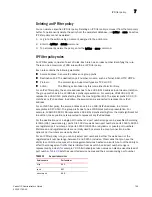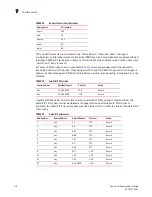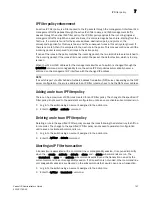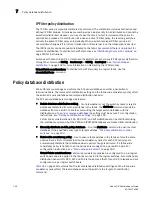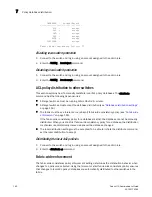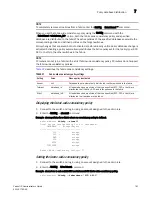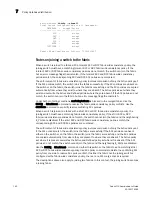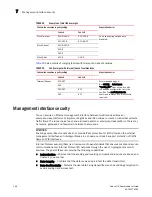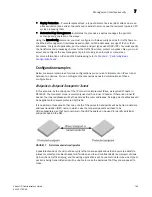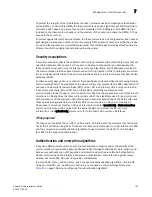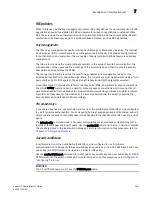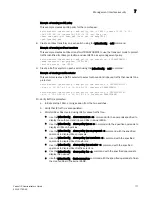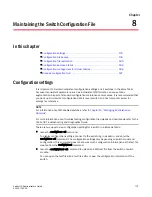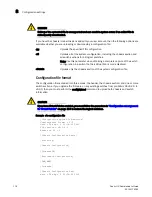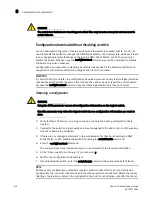
Fabric OS Administrator’s Guide
167
53-1001763-02
Management interface security
7
To protect the integrity of the IP datagram, the IPsec protocols use hash message authentication
codes (HMAC). To derive this HMAC, the IPsec protocols use hash algorithms like MD5 and SHA to
calculate a hash based on a secret key and the contents of the IP datagram. This HMAC is then
included in the IPsec protocol header and the receiver of the packet can check the HMAC if it has
access to the secret key.
To protect against denial of service attacks, the IPsec protocols use a sliding window. Each packet
gets assigned a sequence number and is only accepted if the packet's number is within the window
or newer. Older packets are immediately discarded. This protects against replay attacks where the
attacker records the original packets and replays them later.
Security associations
A security association (SA) is the collection of security parameters and authenticated keys that are
negotiated between IPsec peers. For the peers to be able to encapsulate and decapsulate the
IPsec packets, they need a way to store the secret keys, algorithms, and IP addresses involved in
the communication. All these parameters needed for the protection of the IP datagram are stored
in a security association (SA). The security associations are in turn stored in a security association
database (SADB).
An IPsec security association is a construct that specifies security properties that are recognized by
communicating hosts. The properties of the SA are the security protocol (AH or ESP), destination IP
address, and Security Parameter Index (SPI) number. SPI is an arbitrary 32-bit value contained in
IPsec protocol headers (AH or ESP) and an IPsec SA is unidirectional. Because most
communication is peer-to-peer or client-to-server, two SAs must be present to secure traffic in both
directions. An SA specifies the IPsec protocol (AH or ESP), the algorithms used for encryption and
authentication, and the expiration definitions used in security associations of the traffic. IKE uses
these values in negotiations to create IPsec SAs. You must create an SA prior to creating an
SA-proposal. You cannot modify an SA once it is created. Use the ipsecConfig
--
flush manual-sa
command to remove all SA entries from the kernel SADB and re-create the SA. For more
information on the ipSecConfig command, refer to the
Fabric OS Command Reference
.
IPsec proposal
The IPsec sa-proposal defines an SA or an SA bundle. An SA is a set of parameters that define how
the traffic is protected using IPsec. These are the IPsec protocols to use for an SA, either AH or ESP,
and the encryption and authentication algorithms to use to protect the traffic. For SA bundles,
[AH, ESP] is the supported combination.
Authentication and encryption algorithms
IPsec uses different protocols to ensure the authentication, integrity, and confidentiality of the
communication. Encapsulating Security Payload (ESP) provides confidentiality, data integrity and
data source authentication of IP packets, and protection against replay attacks. Authentication
Header (AH) provides data integrity, data source authentication, and protection against replay
attacks, but unlike ESP, AH does not provide confidentiality.
In AH and ESP, hmac_md5 and hmac_sha1 are used as authentication algorithms. Only in ESP,
3des_cbc, blowfish_cbc, aes256_cbc and null_enc are used as encryption algorithms. Use
Table 41
on page 168 when configuring the authentication algorithm.
Содержание 53-1001763-02
Страница 1: ...53 1001763 02 13 September 2010 Fabric OS Administrator s Guide Supporting Fabric OS v6 4 0 ...
Страница 4: ...iv Fabric OS Administrator s Guide 53 1001763 02 ...
Страница 24: ...xxiv Fabric OS Administrator s Guide 53 1001763 02 ...
Страница 28: ...xxviii Fabric OS Administrator s Guide 53 1001763 02 ...
Страница 32: ...xxxii Fabric OS Administrator s Guide 53 1001763 02 ...
Страница 40: ...xl Fabric OS Administrator s Guide 53 1001763 02 ...
Страница 42: ...2 Fabric OS Administrator s Guide 53 1001763 02 ...
Страница 54: ...14 Fabric OS Administrator s Guide 53 1001763 02 High availability of daemon processes 1 ...
Страница 74: ...34 Fabric OS Administrator s Guide 53 1001763 02 Basic connections 2 ...
Страница 102: ...62 Fabric OS Administrator s Guide 53 1001763 02 Audit log configuration 3 ...
Страница 156: ...116 Fabric OS Administrator s Guide 53 1001763 02 The authentication model using RADIUS and LDAP 5 ...
Страница 214: ...174 Fabric OS Administrator s Guide 53 1001763 02 Management interface security 7 ...
Страница 228: ...188 Fabric OS Administrator s Guide 53 1001763 02 Brocade configuration form 8 ...
Страница 276: ...236 Fabric OS Administrator s Guide 53 1001763 02 Creating a logical fabric using XISLs 10 ...
Страница 404: ...364 Fabric OS Administrator s Guide 53 1001763 02 ...
Страница 440: ...400 Fabric OS Administrator s Guide 53 1001763 02 Performance data collection 17 ...
Страница 464: ...424 Fabric OS Administrator s Guide 53 1001763 02 Disabling bottleneck detection on a switch 18 ...
Страница 480: ...440 Fabric OS Administrator s Guide 53 1001763 02 F_Port masterless trunking 19 ...
Страница 494: ...454 Fabric OS Administrator s Guide 53 1001763 02 Buffer credit recovery 20 ...
Страница 560: ...520 Fabric OS Administrator s Guide 53 1001763 02 Port indexing on the Brocade DCX 4S backbone C ...
Страница 574: ...534 Fabric OS Administrator s Guide 53 1001763 02 Hexadecimal overview E ...



